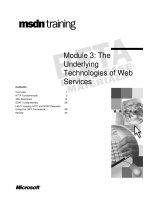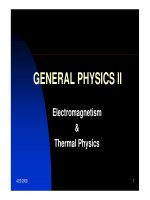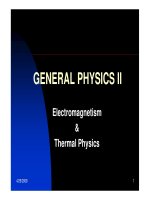- Trang chủ >>
- Khoa Học Tự Nhiên >>
- Vật lý
Tài liệu Chapter XVI The Second Law of Thermodynamics doc
Bạn đang xem bản rút gọn của tài liệu. Xem và tải ngay bản đầy đủ của tài liệu tại đây (1.25 MB, 31 trang )
5/6/2008 1
GENERAL PHYSICS II
Electromagnetism
&
Thermal Physics
5/6/2008 2
Chapter XVI
The Second Law of
Thermodynamics
§1. Reversible Carnot cycles
§2. The second law of thermodynamics
§3. Entropy and quantitative formulation of the second law
§4. Heat engines and refrigerators
5/6/2008 3
The first law of thermodynamics gives the quantiative relations between
the internal energy of a system and the quantities of heat and work that
the system exchange with surroundings. It express the conservation of
energy.
The first law of thermodynamics is true, but not enough ! Why ?
Many thermodynamic processes which don’t violate the 1
st
law,
but don’t happen in nature !
hot
cold
heat flow
• Examples:
In an isolating system
a heat transfer from
the cold part to the hot
part doesn’t happen !
No one has succeded in building a machine that converts heat
completely into mechanical energy
It is necessary to have a supplemental law which says about
the directions of thermodynamic processes → the 2
nd
law
5/6/2008 4
§1. Reversible Carnot cycle:
We are interested in the directions of thermodynamic processes. First we
introduce the concept of reversible and irreversible processes.
1.1 Revisible and irrevisible processes:
Definition: A reversible thermodynamic process is a process which can
takes place in the direct as well as in the reverse way. In the
reverse process the system passes through all the immediate states
that it undergoes in the direct process.
Otherwise the process is called irreversible.
It is observed by experiment that in nature thermodynamic process are
all irreversible process.
But for a theoretical consideration it is convenient to deal with reversible
processes, as idealized models.
5/6/2008 5
1.2 Reversible Carnot cycle:
The reversible Carnot cycle is an idealized model for processe in heat
engines
Consider a cyclic process which is represented
by the closed path P → Q → P.
The mechanical work done in the cycle is
In the P-V diagram, this work is pesented by the area within the closed path.
5/6/2008 6
The Carnot cycle consists of 4 steps:
1) A → B: isothermal expansion to
volume V
B
at temperature T
2
2) B → C: adiabatic expansion to volume
V
C
, tempeature drops to T
1
< T
2
3) C → D: isothermal compression to
volume V
D
at constant temperature T
1
4) D → A: adiabatic compression to the
original state of the system
Exchanges of heat and work in each step: P-V diagram of
a Carnot cycle
• During s-1: the system absorbs heat Q
2
(Q
2
> 0)
and does work W
AB
(W
AB
> 0)
A
B
AB
V
V
nRTWQ ln
22
An ideal gas is used for
working substance
5/6/2008 7
P-V diagram of
a Carnot cycle
• During s-3: the system rejects heat Q
1
,
Q
1
< 0 and the work is done on
the system, W
CD
< 0:
D
C
CD
V
V
nRTWQ ln
11
• For two adiabatic steps s-2 & s-4:
1
1
1
2
CB
VTVT
1
1
1
2
DA
VTVT
&
1
1
1
1
D
C
A
B
V
V
V
V
D
C
A
B
V
V
V
V
2
1
2
1
2
1
)/ln(
)/ln(
T
T
VV
VV
T
T
Q
Q
AB
DC
1
1
2
2
||||
T
Q
T
Q
The ratio of the heat rejected and the heat absorbed is just equal to
the ratio of the temperatures.
5/6/2008 8
What is the results of a cycle ABCDA ?
- The system absorbs heat Q
2
from the
surroundings at temperature T
2
(hot reservoir) , deposits heat Q
1
in the
surroundings at temperature T
1
(cold
reservoir).
- The internal energy of the system
remains unchanged.
- The net mechanical work done by the
system in one cycle is represented by the
area enclosed and is positive. From the 1
st
law:
P-V diagram of
a Carnot cycle
W
net
= |Q2| - |Q1| > 0 (since T
2
> T
1
)
By continously repeating the cycle it is possible to do mechanical work
by continously taking heat energy from a hot reservoir and depositing
a smaller amount of heat energy in a cold reservoir.
Such a device is called a heat engine.
5/6/2008 9
Consider the cycle in the reverse direction A→D→C→B→A:
The result is as follows:
Mechanical work is put into the system in order to take heat energy from
the cold reservoir and deposit heat in a higher-temperature reservoir.
In this case the device is a refrigerator.
We see that heat energy can’t flow from the cold reservoir to the hot
reservoir without action of an external mechanical work.
1.3 Efficiency of a Carnot engine:
Efficiency =
Mechanical work done by engine
Heat energy supplied from the hot reservoir
For a heat engine the efficiency represents the fraction of heat
that is converted to work
5/6/2008 10
From the general definition we can calculate the efficiency of a Carnot
engine:
2
1
2
1
2
12
2
1
||
||
1
||
||||
T
T
Q
Q
Q
Q
W
e
Carnot
Remark:
The efficiency of Carnot engine depends only on the temperatures
of two heat reservoirs
The efficiency is large when the temperature difference is large, and
the efficiency is very small when the temperatures are nearly equal
The efficiency can never be exactly unity unless T
1
= 0. This means
heat can never be converted completely into mechanical work.
Although the Carnot engine is an idealized model, but the conclusions
derived from it give an good orientation for investigation of other heat
engines that we usually encounter.
5/6/2008 11
§2. The second law of thermodynamics:
Experiment evidence suggests that it is impossible to build a heat engine
that converts heat completely to work, that is, an engine with 100% thermal
efficiency. This impossibility is the basis of the following statement of
The second law of thermodynamics.
2.1 “Engine” statement of the second law:
“It is impossible for any system to undergo a process in which it absorbs
heat from a reservoir at a single temperature and converts the heat
completely into mechanical work, with the system ending in the same
state in which it began”.
This statement is also called the Kelvin-Planck statement of the second law.
5/6/2008 12
Some interpretation:
The difference between mechnical energy and heat energy is that they
relate to two different kinds of motion: organized and random motions,
respectively. One can convert the organized motions of molecules to
random motions, but it is difficult to control the random motions of
molecules, thus one can’t convert completely random motions to
organized motions, one can convert a part of it.
Can we build an automobile or power plan by cooling the surrounding
air? It is impossible in practice.
The reason is as follows: the engine receives heat from one body (hot
reservoir), but at the same time needs another body (cold reservoir)
in which it deposits the remaining heat (heat can’t be converted 100%).
5/6/2008 13
2.2 “Refrigerator” statement of the second law:
The second law has also an alternative statement:
“It is impossible for any process to have as its sole result the transfer of
heat from a cooler to a hotter body”.
This is called the “refrigerator” statement, or also the Clausius statement
of the second law of thermodynamics.
This statement means that in order to transfer heat from a cooler to a
hotter body it ís absolutely neccesary to spend a work which does on the
system.
5/6/2008 14
2.3 The equivalency of two statements of the second law:
Two statements my seem to have no relation each to other. But, in fact,
they are completely equivalent.
Suppose that we have a refrigerator which can transfer heat from a cooler
to a hotter body without any external work (the “refrigerator” statement
is violated).
Then we can use this refrigerator in conjuntion with a heat engine,
pumping the heat rejected by the engine back to the hot reservoir
→ violate the “engine” statement.
Suppose that we have a heat engine which can run by receive heat from
the hot reservoir (the “engine” statement is violated).
Then we can use this heat engine in conjunction with a refrigerator. The
output work from the engine can be used for driving the refrigerator that
pumps heat from the cool reservoir and deliver to the hot reservoir without
requiring any input of work → violate the “refrigerator” statement.
Violation of
the “refrigerator” statement
Violation of
the “engine” statement
5/6/2008 15
§3. Entropy and quantitative formulation of the
second law:
We know two equivalent formulation of the second law. But we haven’t
had any equation to express the law.
With the help of the concept of entropy we can write an equation for the
second law
3.1 Definition:
Consider an infinitesimal reversible isothermal expansion of an ideal gas.
For this process:
,0
dU
dV
V
nRT
pdVdWdQ
V
dV
nR
T
dQ
We denote by S the new quantity which has in the considered process
the following change
T
dQ
dS
(for an infinitesimal
reversible process)
5/6/2008 16
For the isothermal reversible expansion from the volume V
1
to V
2
:
1
2
2
1
12
ln
2
1
V
V
nR
V
dV
nR
T
dQ
SSS
V
V
2
1
2
1
12
T
dQ
dSSSS
The entropy change in a reversible process from the intial to final state:
2
1
12
1
T
Q
dQ
T
SSS
For this process we have also:
Here gas expands, V
2
> V
1
→ ΔS > 0, the entropy increases. When
the volume increases, the free space for molecular motions is larger →
the “randomness” is also larger. Thus we can use entropy as a quantittive
measure of disorder.
Units of entropy in SI : J /
0
K
5/6/2008 17
3.2 Entropy changes in a reversible process:
First consider a Carnot cycle. It is a idealized reversible process.
1
1
2
2
||||
T
Q
T
Q
0
1
Q
||
11
0
2
2
1
1
T
Q
T
Q
Recall for a reversible Carnot cycle we have the following equation:
0
21
SSS
There is no net entropy change in one reversible Carnot cycle !
Since
In two adibatic steps there is no heat exchange → the net change
in entropy in one cycle is
5/6/2008 18
Now consider an arbitrary reversible cyclic
process for an ideal gas:
It can beconsidered to be equivalent to
a large number of “thin” Carnot cycles.
For any of “thin” Carnot cycle we have
0
2
2
1
1
T
Q
T
Q
The total entropy change is
0
i
i
i
T
Q
The approximation becomes better as if the
number of subcycles is larger, and every
subcycle is thiner, so we obtain for an arbitrary
reversible cyclic process:
0
T
dQ
5/6/2008 19
A
B
This result leads also to the consequence:
The entropy change of a system in a reversible
process from A to B is independent of the path.
V
P
3.3 A quantitative statement of the second law:
In practise, reversible processes are only idealized situations.
In the real world, friction can never be completely eliminated, and in the
reverse direction of a process, it is difficult for the system to collect back
completely the energy which was lost by friction in the direct process
→ real thermodynamic processes are irrevisible.
2
1
T
dQ
S
doesn’t depend on the path !
5/6/2008 20
Consider an example of irreversible process:
m m
m m
The system consists of two identical metal blocks. The whole system is
thermally isolated from the surroundings.
The initial state a): the temperatures of two blocks are different T
1
& T
2
The final state b): the two blocks in contact → T = (½)(T
1
+ T
2
)
21
21
21
)(
2
1
ln2lnln
2121
TT
TT
mc
T
T
mc
T
T
mc
T
dT
mc
T
dT
mc
T
dQ
T
dQ
S
T
T
T
T
T
T
T
T
5/6/2008 21
Entropy increases
Investigation of various processes in isolated systems show that
For an isolated thermodynamic system ΔS ≥0 ,
This is a quantitative statement of the second law. We have expressed
the second law of thermodynamics by an equation for entropy.
and the equality sign refers to reversible processes
5/6/2008 22
3.4 Microscopic interpretation of entropy:
Molecules are more ordered
Molecules are more
disordered
In the system in picture: Remove partition →
molecules spontanously distribute themselves
throughout the container.
This is an irrevsersible process: molecules
never can spontaneously gather themselves
in one corner as at the beginning.
So ΔS > 0 , entropy increases.
We can conclude that entropy can use as a
quantitative measure of the degree of disorder
in a system.
In the example, entropy increases, at the same
time the degree of disorder of molecules increases also.
Notice that the concepts of order/disorder have the meaning for systems
which consist of a very large number of particles (molecules). For systems
of few particles the concept of entropy plays no any role.
5/6/2008 23
§4. Heat engines and refrigerators:
1. extract heat from a hot reservoir,
2. perform work,
3. dump excess heat into a cold
reservoir (often the environment).
Recycle over and over.
A “reservoir” is a large
body whose temperature
doesn’t change when it
absorbs or gives up heat
W
by
Hot reservoir at T
h
Engine:
Q
h
Cold reservoir at T
c
Q
c
The function: Turn heat into work
The standard heat engine works on a cyclic process:
4.1 Heat engines:
5/6/2008 24
Gasoline (internal-combution) engine :
p
p
b
p
a
V
V
1
V
2
Combustion
exhaust / intake
adiabats
b
a
c
d
P-V diagram for
a idealized model
Is shown in the
picture. It is called
Otto cycle.
Calculate the theoretical efficiency of an Otto cycle
5/6/2008 25
( )
in v b a
Q C T T
| |
by b c d a
W W W
0 (adiabatic) ( )
b c b c b c v b c
Q W U U C T T
similarly ( )
d a d a v d a
W U U C T T
( ) ( )
by v b c v a d
W C T T C T T
p
p
b
p
a
V
V
1
V
2
Combustion
exhaust / intake
adiabats
b
a
c
d
by
in
W
Q
e
)(
)(
1
)(
)()(
ab
dc
abv
davcbv
TT
TT
TTC
TTCTTC
e









